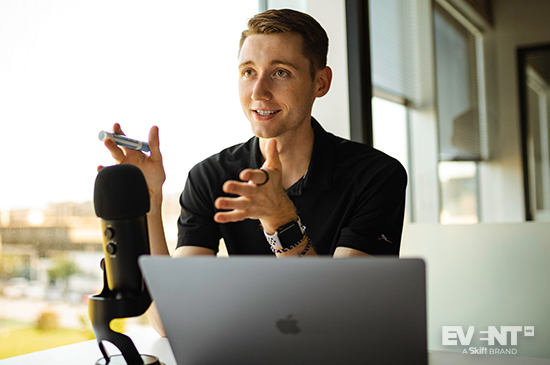Skift Take
Planners aren’t the only eventprofs getting used to virtual events — speakers also have a steep learning curve. One of the most important factors in keeping an audience’s attention is production value. Here’s how speakers and planners can work to deliver it.
The events industry has largely shifted to virtual over the past several months, and despite a brief return to some semblance of live events, the uncertainty surrounding them is mounting with second waves throughout Europe an arguable continuation of the first wave in the US.
All of that is just to say that virtual is here to stay, and as a new format for many eventprofs, there has been a lot to learn in terms of how to deliver a valuable and engaging digital event.
Engaging attendees online has long been a struggle, and delivering high production value is key to doing so successfully — hence the rise of full-fledged, dedicated virtual production studios. But for many events, this task in large part falls to the speakers, many of whom are also adapting to new virtual formats.
Here’s how speakers can make sure they’re equipped with the right tech and best practices for their virtual sessions, and how planners can support them.
What Should Speakers Have in Their Live Streaming Tech Kit?
According to Brandt Krueger, Technical Producer and Consultant at Event Technology Consulting, audio is the most important factor to get right in a virtual session: “In our online events […] it’s very easy to drift into our emails, check our Facebook, etc. But either way, that audio is still going in the background.”
A decent headset or microphone is therefore essential. Once audio is nailed down, speakers should turn their attention to lighting, then video. Krueger notes, however, that speaker tech kits don’t need to cost an arm and a leg. In terms of lighting, for example, a strategically placed desk lamp might do the trick, and there are other affordable options available on Amazon.
Speakers should start with what they have and upgrade when possible. Some events have also been shipping pre-prepared tech kits to speakers, which is another option that will help ensure consistency.
How Should Speakers Prepare for Virtual Event Sessions?
Krueger emphasizes that the most important thing for speakers to do is to experiment with different setups to find what works. A long-forgotten headset may sound much better than Airpods, for example, so it’s all about testing things out. It’s also a good idea to test the lighting at the time of day that they’ll be speaking at the event in order to get an accurate idea of the natural light.
Another way that speakers should prepare for their sessions is to practice their presentations — or as Keneisha Williams, co-founder of Black in Events, puts it: “rehearse like Beyoncé.” The idea is that “when Beyoncé rehearses or does dry runs, it is perfected as if it’s the real thing.” This should be the mindset when it comes to virtual events as well in order to make sure that everything goes as smoothly as possible on the day of the event.
Williams also mentions that it’s important for planners to designate a point of contact so that speakers have someone to reach out to if any issues arise. Speakers, in turn, should make sure they know who the contact is and how they can get in touch if needed.
When Is it Better to Pre-Record the Session?
Liz King, CEO of Liz King Events & techsytalk, also shared some insights during our most recent virtual event, Event Tech Day — specifically about what to keep in mind when deciding to go the pre-recorded route. For starters, one of the main challenges of pre-recorded sessions is that they are generally easy to spot and are more likely to be tuned out by attendees.
That said, pre-recorded sessions can help limit production issues, so they can help events achieve a higher production value if done right. According to King, this means going above and beyond to produce something beautiful that includes features like lower-thirds and overlays — simply recording a Zoom call won’t cut it.
Another option is to include pre-recorded content in the context of simu-live sessions, during which speakers are available live to answer questions. In addition, pre-recorded sessions can be helpful to have as backup content in case anything goes wrong during the live sessions.
IN CONCLUSION
The transition to virtual events has required many planners to change the way they think about events, and speakers have similarly needed to get used to a new format and potentially unfamiliar tools.
As their job is to deliver most of the event’s content, it’s crucial for them to be well-prepared for and comfortable with the digital format, which can be achieved with adequate tech, practice, and support.





